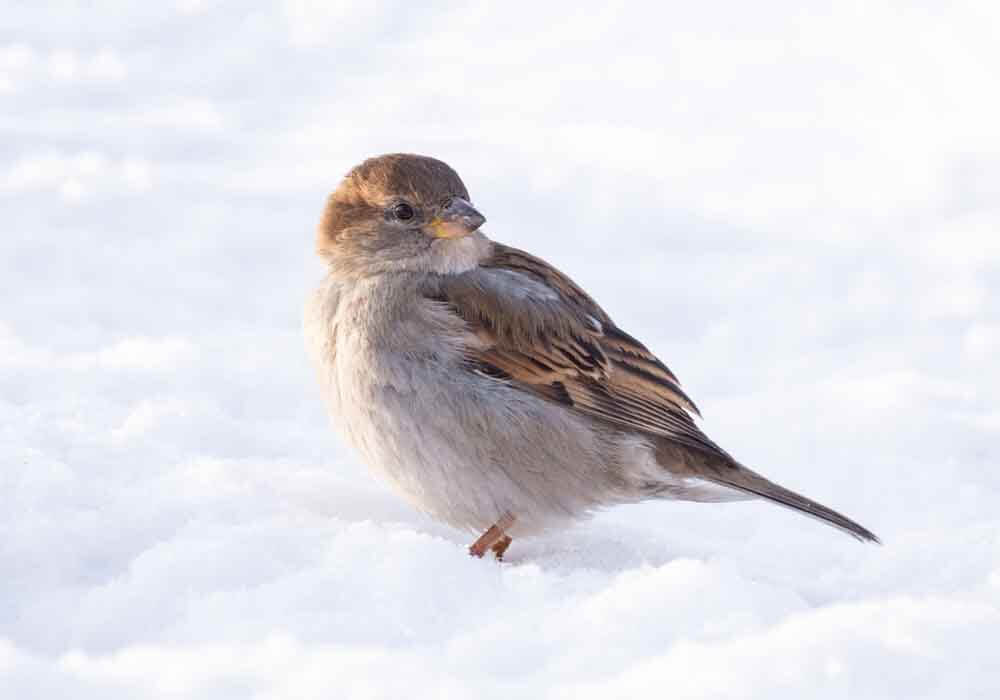Do Birds Get Cold Easily?
Just What Are Their Limits?
When winter comes, our sweaters go on, and fires get lit. While you’re warm and cozy, you may wonder whether birds also feel the winter chill and what protective measures they take to stay warm. Do birds get cold?
Most bird species do get cold. They have unique features that allow them to keep warm.- they grow thicker feathers and huddle together. Some birds also migrate when it gets too cold.
Read on to find out more about what happens when birds get cold and to understand the many physical adaptations that help birds stay warm. This article will also provide some helpful advice if you want to help birds survive the winter. Let’s get started!

At What Temperature Do Birds Get Cold?
Most birds begin to get cold when the temperature falls below 10 degrees Celsius (50 degrees Fahrenheit). However, when temperatures drop even further, below 4 degrees Celsius (40 degrees Fahrenheit) they can quickly mobilize all the internal mechanisms they have to keep warm.
What Temperature Is Too Cold for Birds?
It is too cold for most birds when the temperature reaches 4-5 degrees Celsius (40-41 degrees Fahrenheit). In these temperatures, birds' natural adaptations may not be enough to keep them warm. Most birds may be at risk of freezing to death if it gets colder.
Do Birds Get Cold During Winter?
Birds do get cold during winter. However, they have developed a wide range of defense mechanisms against cold. These include growing an extra set of feathers, shivering, and putting on fat. Some birds will look for natural alcoves to shelter in. During the night, some birds enter torpor.
This article explores the different strategies that birds use to keep themselves warm.

Most birds everywhere experience cold circumstances, even extreme cold...so how do they keep their feet warm in cold contitions? Here's an article of ours that explains how they do it.
Physical Adaptations
In winter, many birds undergo several transformations that will help keep them warm. Birds like geese will grow an extra set of down feathers as insulation. Other birds will spend their days looking for fatty food sources. This added layer of fat also acts as insulation.
Small birds like cardinals can change their body shape - they puff up their bodies into round balls, so there is less chance of heat loss. Some birds also secrete a special oil from their tail glands which helps waterproof their feathers.
Like humans and many other animals, birds shiver to stay warm. Shivering signals nerve impulses being sent to the brain to generate heat. Shivering is typically triggered when the core body temperature drops.
Gathering Together
During winter, you may notice birds' community behavior increases. The main reason why they group together is to share body warmth. Typically, these birds will look for tree cavities and evergreen trees to shelter from the wind and cold, and then hurdle to make the most out of what little heat they have.
Can Birds Freeze to Death?
Birds can freeze to death, even though they have developed a variety of mechanisms to prevent them from doing so. Birds can die if the winter is especially cold or harsh. They can also freeze if injured or have difficulty finding food or shelter.
Here’s a closer look at some of the reasons why a bird may freeze to death:
- Harsh winters. Birds have adapted to cold weather but may not fare well when raining or hailing. If a bird gets its feathers wet, it may die because it can no longer regulate its body temperature.
- Injuries. During winter, birds must be highly active to maintain their body temperature. If they are injured, they will not only be able to find food but also be unable to keep warm through activity.
- Difficulty finding food or shelter. During some winters, birds may find it hard to find enough fatty food sources or alcoves to shelter in. They may freeze to death if they cannot find what they need.
Torpor
During the night, birds enter a state called torpor, slowing their body functions and metabolic rate. This helps birds conserve their energy so they can use it during the day to stay warm. Before entering a torpor, birds must find a sheltered place to protect themselves from predators.
Do Birds Get Cold Feet?
Birds’ feet get physically cold, especially if roosting on frozen ground or cold branches. However, many birds do not feel uncomfortable when their feet become cold. This is because the blood in their feet is isolated from the rest of their bodies.
Several adaptations minimize the effect of cold feet:
- Countercurrent heat exchange. Birds' arteries (which carry warm blood) and their veins (which carry cold blood) are very close to their feet. As a result, the blood temperature from the feet is regulated before it reaches the rest of the body.
- Specialized scales. Birds' feet have unique scales that are designed to reduce heat loss.
- Standing on one foot. Many birds, like pelicans, gulls, and ducks, stand only on one foot at a time during the winter months. This allows them to keep one leg warm at a time.
- Few pain receptors. Some birds, like snow buntings and common eiders, have very few pain receptors in their feet. Even if their feet reach near-freezing temperatures, they won’t be able to feel the cold.
Do Birds Get Cold Flying?
Birds don’t get cold when flying. Instead, they generate heat during the process because they flap their wings so hard and fast. During winter, you might find birds flying harder and longer than usual. That’s because they’re trying to generate some additional warmth.
Do Baby Birds Get Cold?
Baby birds are more vulnerable to cold and winter than adult birds. This is because baby birds can’t regulate their own temperature when they are newly born. They can only keep warm by staying in their nest and close to their parents and nestmates.
Most baby birds are born during spring, so they don’t have to grapple with cold weather. Once winter arrives, birds are fully grown and can keep themselves warm through various activities and adaptations.
 |
We have all kinds of interesting articles that pertain to bird anatomy! Here's just a few you'll like... |
Where Do Birds Go When It Gets Cold?
Some birds migrate to warmer climates when it gets cold in the winter. Different birds follow different migrational patterns. In America, some birds migrate to the Southern United States, others to Mexico and CentralAmerica, and others further to the Caribbean.
Here’s a closer look at what birds migrate where during the winter:
- Southern United States. The southern states in the US have fewer harsher winters than the Northern states. Birds like tree swallows and warblers will go to the Southern states as they can tolerate small cold snaps.
- Mexico. Just before winter, hummingbirds, tanagers, and kingbirds will all migrate down to Mexico, which has a forgiving, tropical climate.
- The Caribbean. Warblers and buntings will fly from North America to islands in the Caribbean just before the winter.
Typically, birds will migrate to warmer climates during fall. They follow complex, internal navigational patterns and migrate in flocks, allowing them to select the right location for winter.
How Can You Help Birds When It Gets Cold?
You can help birds when it gets cold by putting out fresh food and water. You can also provide birds with a place to find shelter and keep warm. Take extra care of injured birds during winter.
Here’s some more information on how you can support birds during winter.
Put Out Fresh Food and Water
Try to keep a well-stocked bird feeder all through winter. Plenty of food for birds will help them build on their body fat, which will keep them warm. Provide high fat and nutritious foods, including:
- Nuts
- Lard
- Seeds
- Suet
- Cheese
- Sunflower seeds
- Mixed seeds
Try not to give the birds too much bread as it has very little nutritional value. You should also avoid putting out milk as it may lead to dehydration. Instead, have plenty of fresh water on offer.
As well as keeping your bird feeder well stocked, you can grow plants like holly, crab apples, Virginia creepers, and winterberries. These will grow berries that are highly nutritious for birds.
Provide Shelter for the Birds
Plants can also provide an excellent shelter for birds to keep themselves warm. Other types of shelters you can provide include evergreen plants, brush piles, roost boxes, and store-bought winter birdhouses. Providing birds with shelter helps them keep warm and also protects them from predators that take advantage of birds to increase visibility during winter.
Take Extra Care of Injured Birds
If you find an injured bird in winter, try to take it to a veterinarian specializing in birds. During spring and summer, birds will recover from injuries quickly. In winter, their injuries may make them succumb to the cold. It is especially harmful if a bird injures its wings as they rely on flapping their wings and fluffing their feathers to get warm.

Did you know that we have over 20 fascinating articles on a whole range of bird topics on our Bird Information and Facts page? Take a flight over there and check them out!
Do Birds Get Cold?...Final Thoughts
Birds get cold in the winter but have a variety of defense mechanisms that help them survive the chill. Some migrate while others grow extra feathers, undergo physical changes, or flock together to stay warm. You can do a lot to help birds survive harsher winters, including providing them with food and shelter.
Back To The TOP Of This Do Birds Get Cold Page

About the Author...
Richard Worden, a dedicated bird lover for over 20 years, I love to share my in-depth knowledge and passion for birds. Read more About Me and my expertise in this field.
- We Know Birds HOME ›
- Bird Facts and Information ›
- Do Birds Get Cold Easily?
